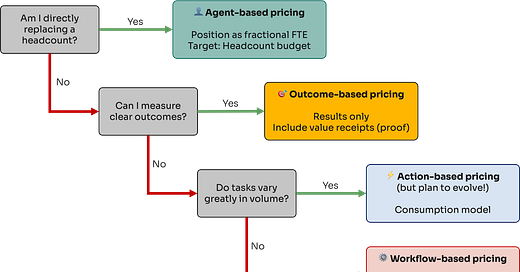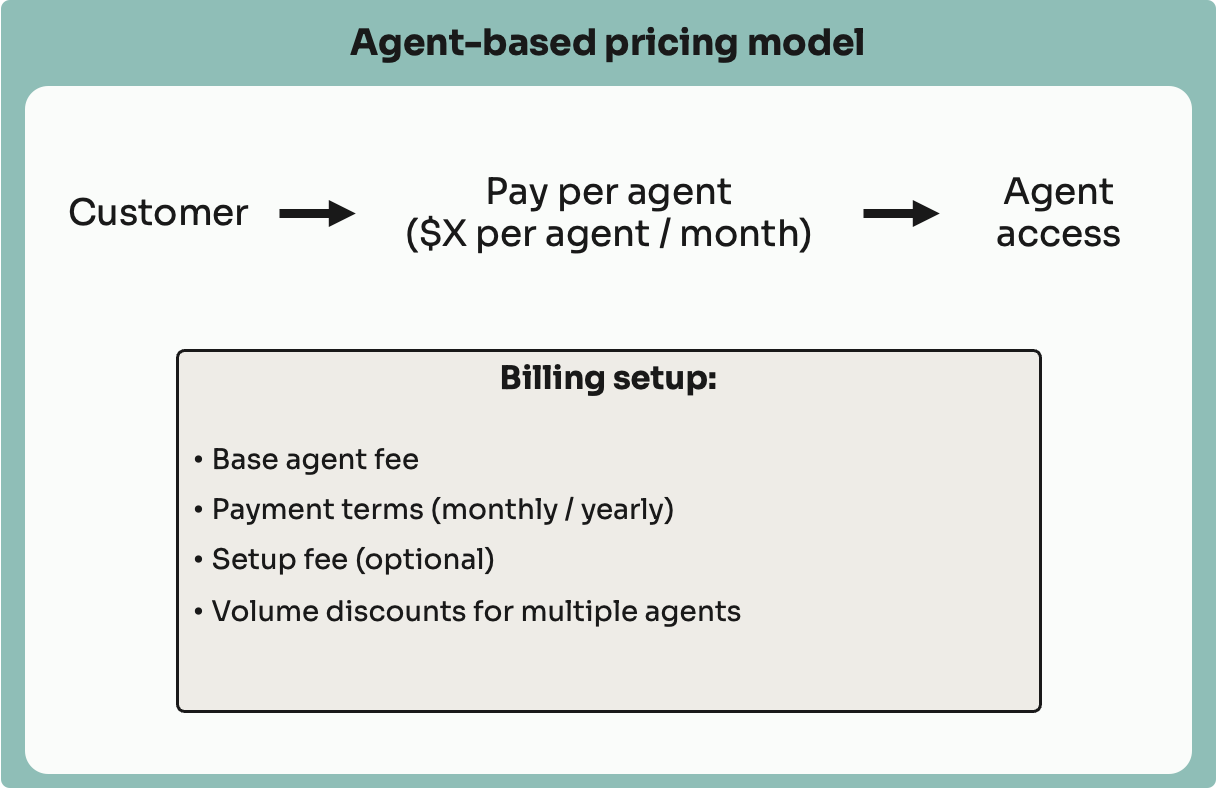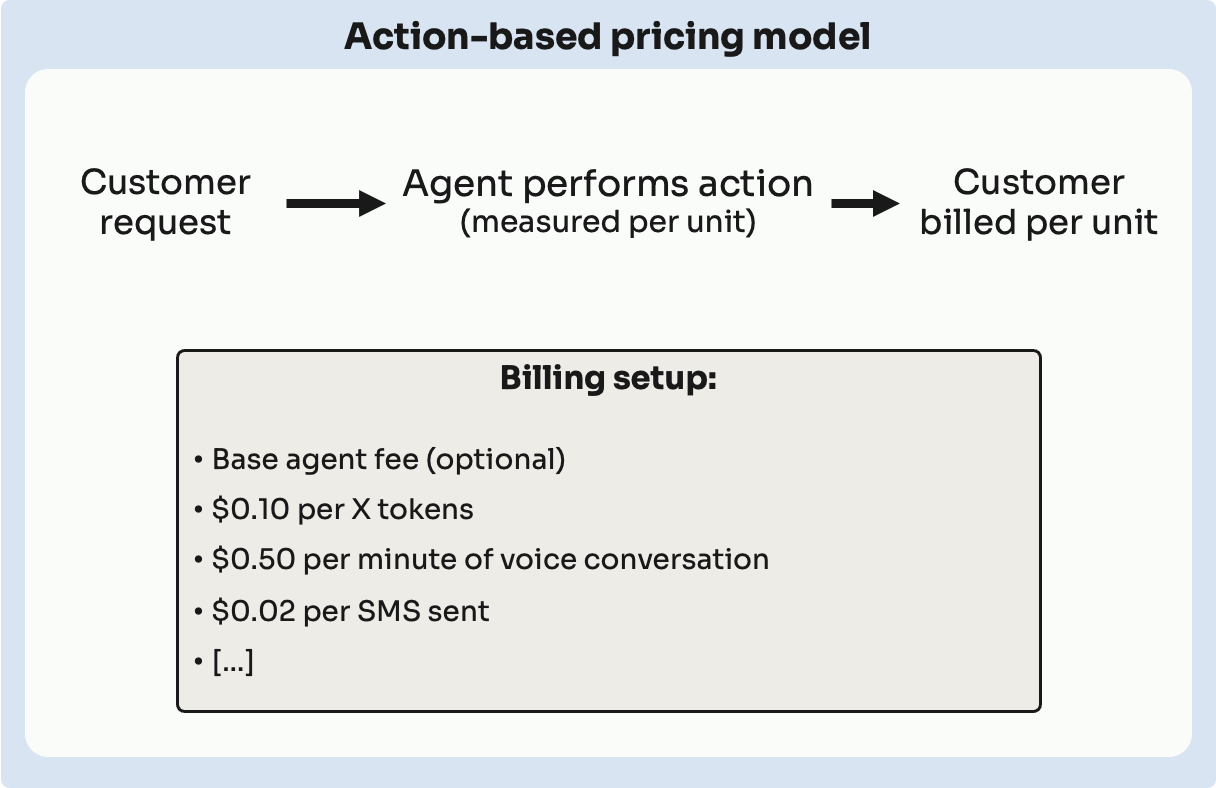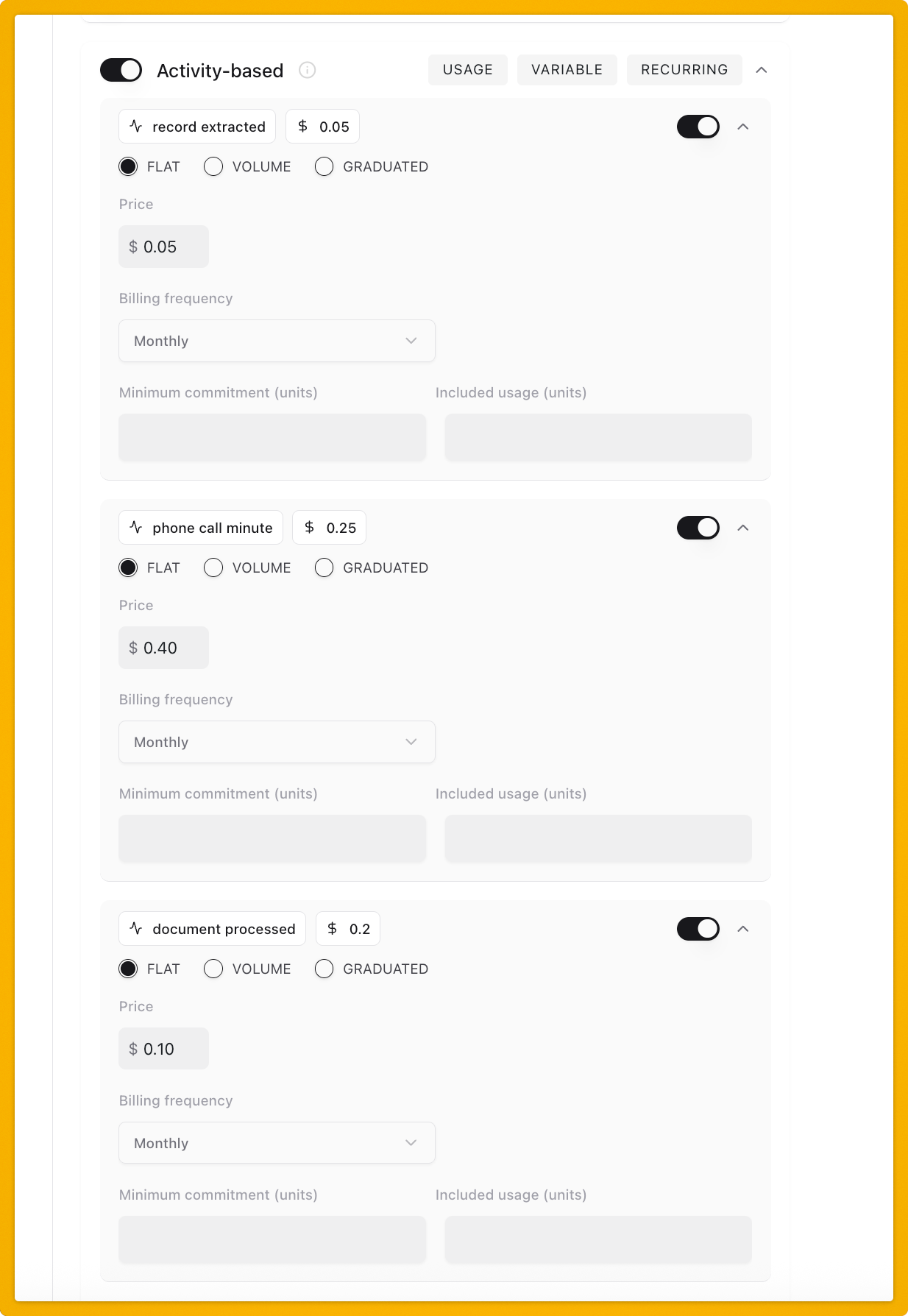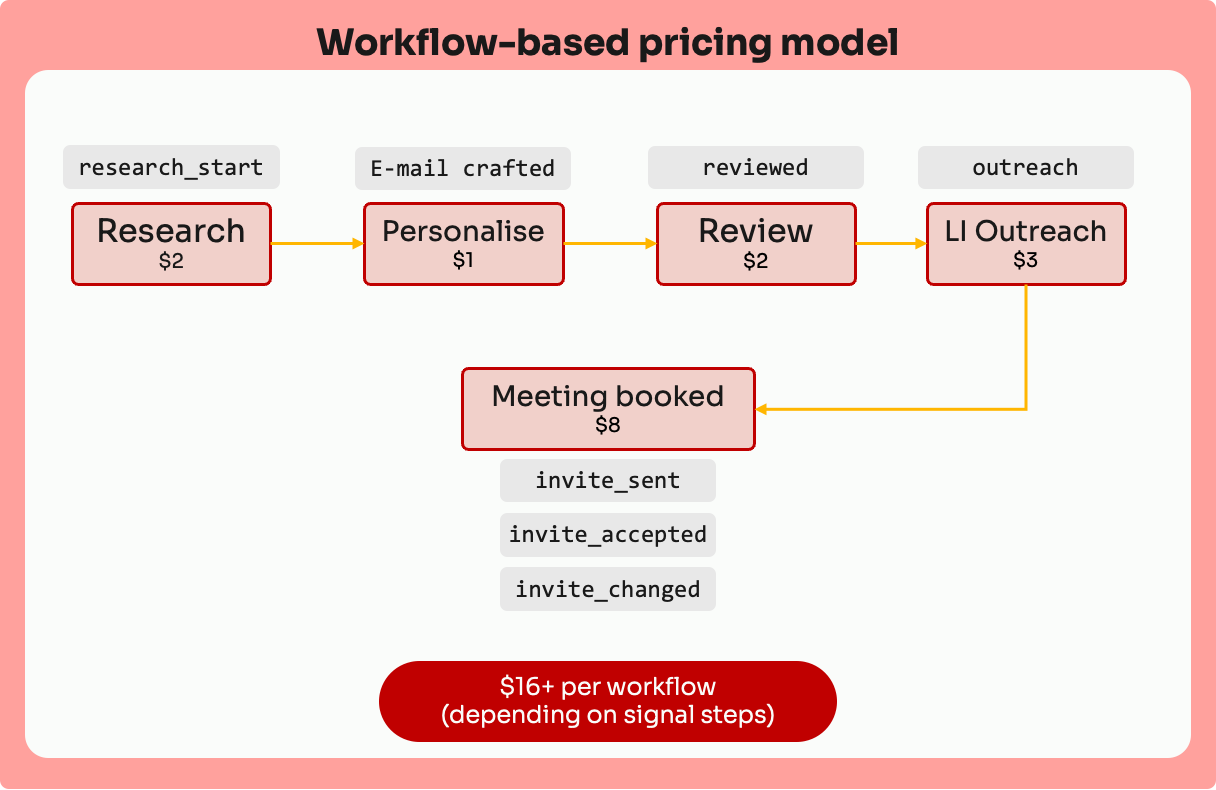The Complete Guide to AI Agent Monetization
Transform your AI agents from cost centers to revenue generators with Paid's proven monetization frameworks
I don’t need to tell you again, but the AI agent economy is exploding.
This year, tens of thousands of businesses have deployed millions of AI agents across every industry.
Most companies (over 75%!) struggle with a critical question: How do we turn these AI tools into sustainable revenue streams?
At Paid, we've pioneered the infrastructure that powers monetization for the world's most successful AI agents.
This guide shares our proven frameworks to help you design, implement, and scale your agent monetization strategy.
The four AI Agent pricing models dominating the market
We've identified four fundamental monetization frameworks proven by 60+ AI agent companies, each suited to different agent types and business models:
1. 👤 Agent-Based Framework: The FTE Replacement Model
2. ⚡ Action-Based Framework: The Consumption Model
3. ⚙️ Workflow-Based Framework: The Process Automation Model
4. 🎯 Outcome-Based Framework: The Results-Based Model
Comparison at a Glance
🧭 Decision framework: choose your model
Use this decision framework to select the optimal pricing model for your AI agent:
Key questions to ask:
What budget am I targeting?
Headcount budget (10x larger) → Agent-based
BPO/outsourcing budget → Action-based
ROI/performance budget → Outcome-based
How commoditized is my offering?
Unique capabilities → Any model works
Standard features → Avoid the action-based model
Can I prove my value?
Clear attribution → Outcome-based
Process efficiency → Workflow-based
Time savings → Agent-based
🏢 Agent-based pricing
Agent-based pricing treats AI agents like digital employees where customers pay a fixed recurring fee for each agent deployed.
This model positions agents as FTE replacements, tapping into headcount budgets rather than IT budgets.
Companies like 11x, Harvey, and Vivun have proven this approach can command premium pricing by directly competing with human hiring costs.
How It Works
Design Principles
Position as Digital Employee: Frame your agent as a FTE replacement
Tap Headcount Budgets: Target 10x larger budgets than traditional software
Demonstrate Clear ROI: Show savings vs. $60,000/year junior employee
Bundle Capabilities: Add features to justify premium pricing and resist commoditization
Implementation Guide
Step 1: Define Your Agent Tiers
Starter: Basic functionality, single user
Professional: Full features, team access
Enterprise: Custom limits, SLA guarantees
Step 2: Set Pricing Anchors
Research competitor SaaS pricing in your domain
Price 20-30% below equivalent human cost
Build in margin for infrastructure and support
Step 3: Configure in Paid
Real-World Examples from our customers
Example 1: Legal Document Review agent
Agent: AI Legal Assistant for contracts
Functionality: Reviews contracts, identifies risks, suggests edits
Pricing Model:
Starter: $3,000/month (up to 50 contracts)
Professional: $8,000/month (up to 200 contracts)
Enterprise: $20,000/month (unlimited contracts, API access)
Why it works: Law firms have predictable document volumes and prefer fixed costs for budgeting
Example 2: Customer Success agent
Agent: Churn protection / retention AI
Functionality: Monitors customer health, predicts churn, automates interventions
Pricing Model:
Small Business: $1,500/month (up to 500 customers)
Growth: $5,000/month (up to 2,500 customers)
Scale: $15,000/month (up to 10,000 customers)
Why it works: SaaS companies want predictable costs tied to their customer base size
When to choose agent-based pricing
✅ Your agent performs a comprehensive set of tasks replacing a job function
✅ Customers want budget predictability from headcount allocations
✅ You can demonstrate clear FTE replacement value
✅ Competition prices on seat-based models
✅ You want to avoid race-to-bottom pricing pressure
⚠️ Future-proofing tip: As LLM costs drop 10-100x, shift your value prop from "cheaper than human" to "vastly more capable than human"
⚡ Action-based pricing
Action-based pricing charges customers for every discrete action their agents perform.
Used by agentic companies like Bland and Parloa, this consumption model mirrors cloud infrastructure and BPO pricing.
It's transparent but vulnerable to commoditization as AI costs decline.
How It Works
Pricing principles
Transparent Consumption: Direct correlation between usage and cost
Low Barrier to Entry: Customers only pay for what they use
BPO Competition: Target the $900/employee BPO market
Volume Discounts: Incentivize higher usage with tiered pricing
Implementation guide
Step 1: Calculate unit economics
Determine base LLM/infrastructure costs
Add 50-300% margin based on value delivered
Build in cushion for future cost reductions
Step 2: Define billable actions
Real-World Examples
Example 1: AI Voice Agent (Bland.ai Model)
Agent: Call AI
Functionality: Handles inbound customer service calls
Pricing Model:
$0.12/minute for inbound calls
$0.18/minute for outbound calls
Volume discounts: 10% off at 10,000 minutes/month
Why it works: Direct competition with call centers at 70% lower cost
Example 2: Document Processing Agent
Agent: Document parsing AI
Functionality: Extracts data from invoices, receipts, contracts
Pricing Model:
$0.10 per page processed
$0.02 per data field extracted
Bulk pricing: $500 for 10,000 pages/month
Why it works: Clear unit economics vs. manual data entry costs
When to Choose Action-Based
✅ Competing directly with BPOs or call centers
✅ Highly variable usage patterns
✅ Customers want "pay only for what you use"
✅ Simple, discrete, measurable actions
✅ Testing market fit with low commitment
⚠️ Warning: This model faces the highest pricing pressure as AI costs plummet. Plan to transition to workflow or outcome-based pricing within 12-18 months.
⚙️ Workflow-based pricing
Workflow-based pricing charges for complete sequences of agent actions that deliver specific intermediate outcomes.
Companies like Rox, Salesforce, and Artisan use this model to balance between pure consumption and outcome pricing. Each workflow represents a meaningful business process with clear deliverables.
How It Works
Design Principles
Process-Level Value: Price complete workflows, not individual actions
Complexity Protection: Complex workflows resist commoditization
Clear Deliverables: Each workflow produces measurable intermediate outcomes
Margin Management: Monitor workflow costs to avoid negative margins on complex processes
Implementation Guide
Step 1: Map your workflows
You want to identify the actions and assign some values to the steps.
Identify all discrete actions your agent performs
Estimate resource consumption per workflow
Assign business value to each workflow
Step 2: Design pricing structure
Here, you set prices to cover your margins and costs.
Set base platform fee (covers overhead)
Price each workflow based on:
Computational cost
Business value delivered
Market alternatives
Step 3: Add commitment tiers
Commitment tiers and included quantities are easy ways to force a minimum revenue, but they can backfire if you don’t explain to your customer what they get.
Here’s how you set them in Paid:
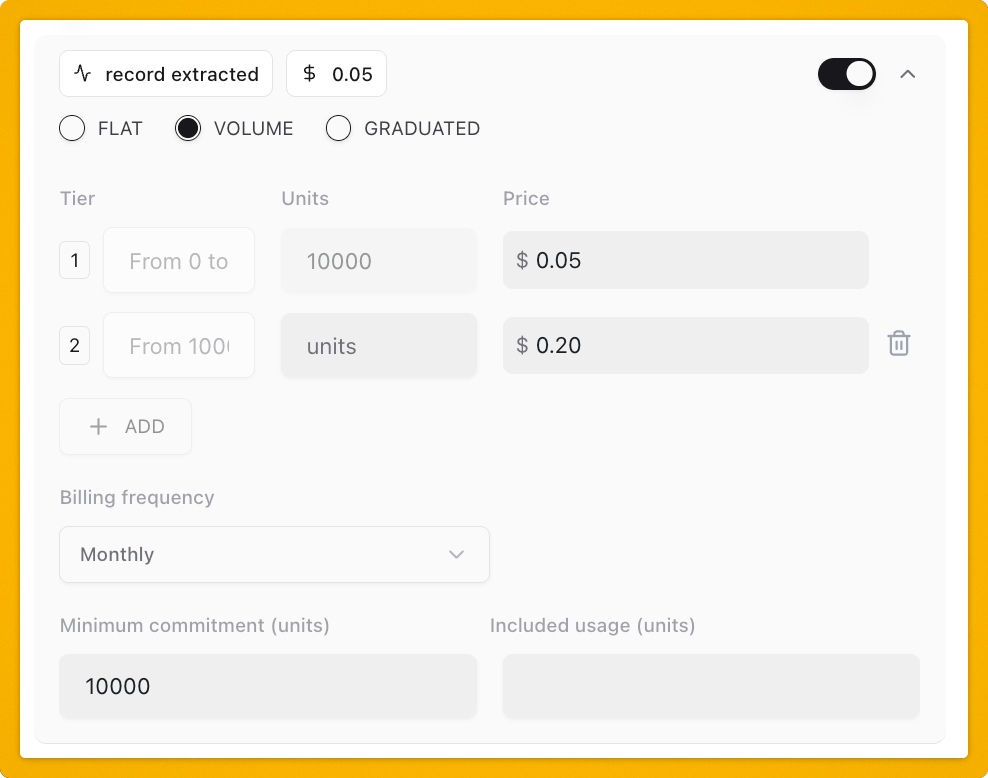
Real-World Examples
Example 1: Sales Development Representative (SDR) Agent
Agent: Automated SDR
Hybrid setup:
Base platform fee: $3,000/month (platform access)
Workflow pricing:
Lead Research: $2 per lead profiled
Email Personalization: $1 per email crafted
LinkedIn Outreach: $3 per connection request
Meeting Booking: $8 per meeting scheduled
Optional commitment packages:
Starter: 500 leads/month minimum ($5,000 guaranteed revenue)
Growth: 2,000 leads/month minimum ($2,500 guaranteed revenue)
Scale: 10,000 leads/month minimum ($5,000 guaranteed revenue)
Why it works: Sales teams can start small and scale with success
Example 2: Financial Analysis Agent
Agent: Automated CFO Assistant
Hybrid setup:
Base platform fee: $5,000/month
Workflow Pricing:
Report creation: 20 included, $100 for every overage
Cash Flow Forecast: $250 per forecast
Budget vs Actual Report: $50 per department
Board Deck Generation: $500 per deck
Real-time Dashboard Update: $25 per refresh
Optional volume discounts: 20% off after 50 workflows/month
Why it works: Finance teams have varying needs throughout the month/quarter
When to Choose Workflow-Based
✅ Your agent executes multi-step processes with clear deliverables
✅ Workflows are standardized but complex enough to avoid commoditization
✅ You can demonstrate ROI for each workflow type
✅ Different workflows deliver different business value
✅ You want pricing flexibility between action and outcome models
⚠️ Watch Out For:
Complex workflows (document parsing, security scans) risk negative margins. Make sure you segment your workflows for length or complexity to avoid having your margins crushed.
Monitor costs carefully to maintain profitability!
🎯 Outcome-based pricing
Outcome-based pricing represents the pinnacle of value-aligned pricing and the model most resistant to commoditization.
Companies like Zendesk, Intercom, Airhelp, and Chargeflow charge only for successful business results. As we note in our frameworks article with Kyle Poyar,, this model will likely dominate as AI costs plummet.
It's the only model that completely decouples pricing from underlying technology costs.
How It Works
This model is similar to the workflow-based pricing model. Even though you can combine it with a platform fee and others, you should avoid pricing individual “attempts”.
Has there been success? Bill.
No success? Don’t charge.
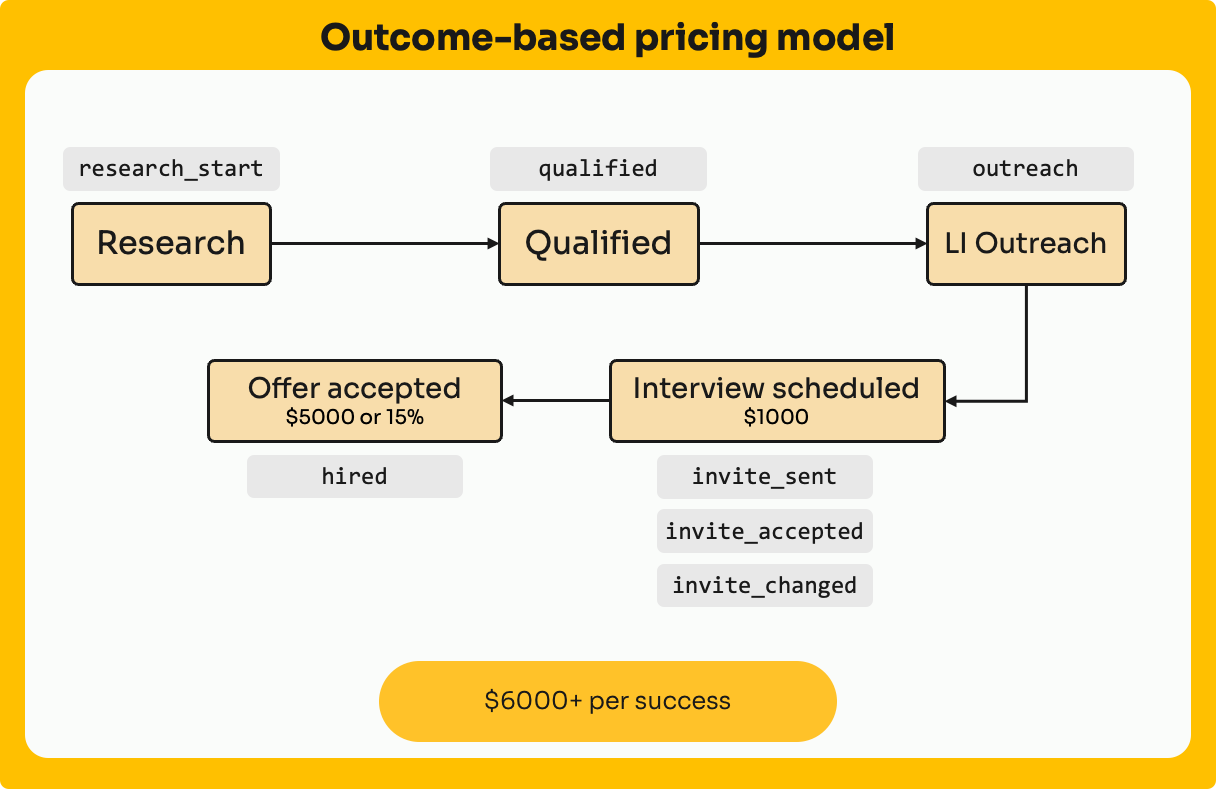
Design Principles
Results-only focus: Charge only for achieved outcomes, not attempts.
Clear attribution: Develop robust methodologies to prove your impact
Shared risk AND reward: Include performance guarantees or success bonuses, like revenue share.
Premium positioning: Command highest prices through guaranteed results
Future-proof: This model is the most resistant to AI commoditization
Implementation guide
This model is the trickiest to get right, so follow carefully!
Step 1: Define success metrics
These must be objectively measurable
Directly tied to business value for best success
Step 2: Calculate Risk-Adjusted Pricing
Estimate success rate of your agents
Add risk premium (typically 30-50% with most of our customers)
Include a base platform fee to cover operational costs if no success is reached
Setup in Paid is similar to the workflow setup, but prioritizes outcomes and not just actions.
Real-World Examples
Example 1: Recruiting Agent
Agent: Automated Recruiter
Base Fee: $2,000/month (platform access, unlimited searches)
Outcome Pricing:
Qualified Candidate Submitted: $500
Interview Scheduled: $1,000
Offer Accepted: $5,000 or 15% of first-year salary
Success Metrics:
Interview: Candidate completes first round with hiring manager
Offer Accepted: Candidate signs offer letter
Why it works: Recruiting is already outcome-based; AI agent follows industry model
Example 2: E-commerce Optimization Agent
Agent: Conversion Rate Optimizer
Base Fee: $500/month (A/B testing infrastructure)
Outcome Pricing:
Conversion Rate Improvement: $2,000 per percentage point
Revenue Increase: 5% of incremental revenue
Cart Abandonment Reduction: $50 per recovered cart
Success Metrics:
Conversion: Measured via integrated analytics, 30-day attribution
Revenue: Year-over-year comparison, seasonally adjusted
Cart Recovery: Completed purchase within 7 days of intervention
Caps: Maximum $50,000/month to prevent runaway costs
Why it works: Direct tie to revenue makes ROI crystal clear
When should you choose Outcome-based pricing?
✅ Success can be clearly measured and attributed
✅ Your agent consistently delivers quantifiable results
✅ Market already expects outcome-based pricing (e.g., recruiting, sales)
✅ You want maximum pricing power and differentiation
✅ You're confident in your agent's performance
💡 Tip: This is the most future-proof model. As AI costs approach zero, outcome-based pricing maintains margins by focusing on value delivered, not resources consumed.
💡 Paid’s best practices for agent monetization
1. Start simple, evolve sophisticated
Launch with agent-based pricing
Add usage components as you learn
Introduce outcomes once proven
2. Transparency builds trust
Real-time usage dashboards
Clear billing breakdowns and value receipts
Proactive cost alerts
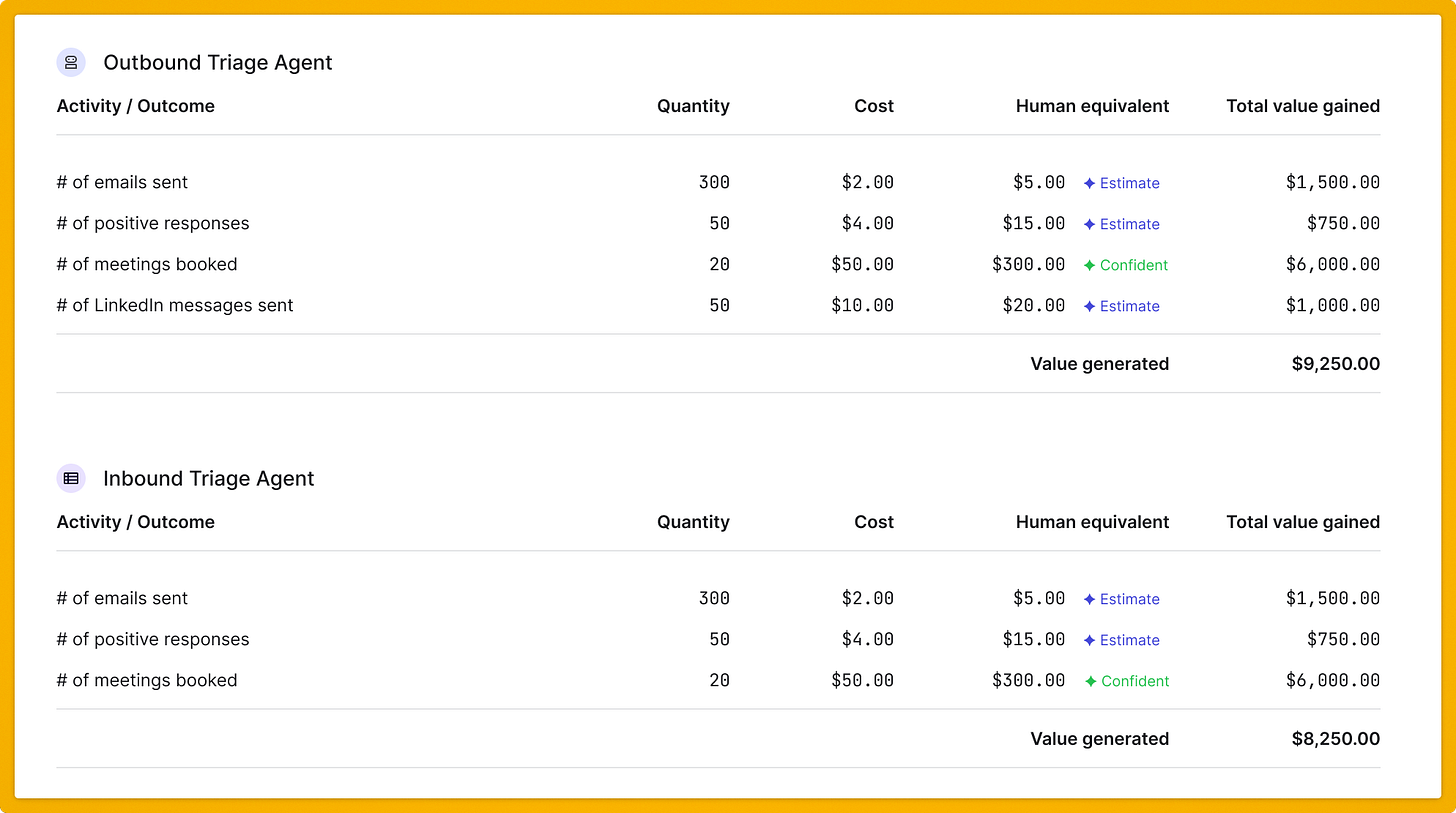
3. Price for value (not cost)
Research alternative solutions
Understand customer budgets
Price below human equivalent
Leave room for discounting
4. Monitor and iterate - experiment frequently
Track key metrics:
Customer acquisition cost
Lifetime value
Churn rate by pricing model
Usage patterns
A/B test pricing changes
Survey customers quarterly - not just those who churn
🤝 Why Paid?
Paid is the only billing infrastructure built specifically for the AI agent economy:
Agent-Native: Purpose-built for AI monetization patterns
Real-Time: Instant usage tracking and billing
Flexible: Supports all monetization frameworks described above
Integrated: Works with your existing stack - Python, Node.JS, Go, Ruby, n8n, Zapier, and more.
Ready to Monetize?
Transform your AI agents into revenue generators:
Book an intro meeting: Our monetization experts will design a custom framework for your agents - visit Paid.ai to schedule your personalized monetization consultation.


